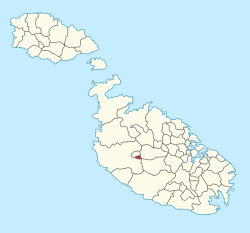Our website is made possible by displaying online advertisements to our visitors.
Please consider supporting us by disabling your ad blocker.
Mdina
Mdina
L-Imdina (Maltese) Città Notabile, Città Vecchia Ann, Melite, Melita | |
|---|---|
City and Local council | |
| Nickname: The Silent City | |
 | |
| Coordinates: 35°53′9″N 14°24′11″E / 35.88583°N 14.40306°E | |
| Country | |
| Region | Northern Region |
| District | Western District |
| Established | c. 8th century BC as Ann c. 11th century AD as Mdina |
| Borders | Attard, Mtarfa, Rabat |
| Government | |
| • Mayor | Peter Sant Manduca (PN) |
| Area | |
• Total | 0.9 km2 (0.3 sq mi) |
| Population (Aug. 2023) | |
• Total | 250 |
| • Density | 280/km2 (720/sq mi) |
| Demonym(s) | Midjan (m), Midjana (f), Midjani (pl) |
| Time zone | UTC+1 (CET) |
| • Summer (DST) | UTC+2 (CEST) |
| Postal code | MDN |
| Dialing code | 356 |
| ISO 3166 code | MT-29 |
| Patron saints | St. Peter St. Paul Our Lady of Mount Carmel |
| Day of festa | 29 June 4th Sunday of July |
| Buses 50, 51, 52, 53, 56 from Valletta terminus, stop at bus stop named "Rabat 3"[1] | |
Mdina (Maltese: L-Imdina [lɪmˈdiːnɐ]; Italian: Medina), also known by its Italian epithets Città Vecchia ("Old City") and Città Notabile ("Notable City"), is a fortified city in the Northern Region of Malta which served as the island's former capital, from antiquity to the medieval period. The city is still confined within its walls, and has a population of 250.[2]
A natural redoubt, the area of the city has been inhabited since prehistory. A Phoenician colony known as Ann (Phoenician: 𐤀𐤍𐤍, ʾNN) was established around the 8th century BC, sharing its name with the island and presumably acting as its capital. During the Punic Wars, the town was acquired by the Romans and renamed Melita (Ancient Greek: Μελίτη, Melítē) after the Greek and Latin name for the island, probably taken from the Punic port at Cospicua on the Grand Harbour. Greco-Roman Melite was larger than present-day Mdina. It was reduced to its present size during the period of Byzantine or Arab rule. Following a 9th-century massacre, the area was largely uninhabited until its refounding in the 11th century as Madīnah, from which the town's current name derives. Mdina then continued to serve as the capital of Malta until the arrival of the Order of St. John in 1530, who used Birgu instead. Mdina experienced a period of decline over the following centuries, although it saw a revival in the early 18th century during which several Baroque buildings were erected.
Largely maintaining its medieval character, Mdina remained the centre of the Maltese nobility and religious authorities and property continues to largely be passed down from families and from generation to generation. It never regained its pre-1530 importance, however, giving rise to the popular nickname the "Silent City" by both locals and visitors.[3] Mdina is on the tentative list of UNESCO World Heritage Sites, and it is now one of the main tourist attractions in Malta.[4]
- ^ "Route Map". Malta Public Transport. 19 April 2016. Archived from the original on 3 May 2016.
- ^ "Estimated Population by Locality 31st March, 2014". Government of Malta. 16 May 2014. Archived from the original on 21 June 2015.
- ^ "Mdina & Rabat". VisitMalta. Archived from the original on 13 June 2020.
- ^ Blasi, Abigail (29 September 2014). "Top 10 day trips in Malta". Lonely Planet. Archived from the original on 10 October 2015.
Previous Page Next Page










